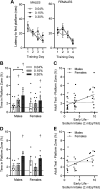Dissociable effects of dietary sodium in early life upon somatic growth, fluid homeostasis, and spatial memory in mice of both sexes
- PMID: 33439766
- PMCID: PMC8238146
- DOI: 10.1152/ajpregu.00281.2020
Dissociable effects of dietary sodium in early life upon somatic growth, fluid homeostasis, and spatial memory in mice of both sexes
Abstract
Postnatal growth failure is a common morbidity for preterm infants and is associated with adverse neurodevelopmental outcomes. Although sodium (Na) deficiency early in life impairs somatic growth, its impact on neurocognitive functions has not been extensively studied. We hypothesized that Na deficiency during early life is sufficient to cause growth failure and program neurobehavioral impairments in later life. C57BL/6J mice were placed on low- (0.4), normal- (1.5), or high- (3 g/kg) Na chow at weaning (PD22) and continued on the diet for 3 wk (to PD40). Body composition and fluid distribution were determined serially by time-domain NMR and bioimpedance spectroscopy, and anxiety, learning, and memory were assessed using the elevated plus maze and Morris water maze paradigms in later adulthood (PD63-PD69). During the diet intervention, body mass gains were suppressed in the low- compared with normal- and high-Na groups despite similar caloric uptake rates across groups. Fat mass was reduced in males but not in females fed low-Na diet. Fat-free mass and hydration were significantly reduced in both males and females fed the low-Na diet, although rapidly corrected after return to normal diet. Measures of anxiety-like behavior and learning in adulthood were not affected by diet in either sex, yet memory performance was modified by a complex interaction between sex and early life Na intake. These data support the concepts that Na deficiency impairs growth and that the amount of Na intake which supports optimal somatic growth during early life may be insufficient to fully support neurocognitive development.
Keywords: growth; neurobehavior; sodium.
Conflict of interest statement
No conflicts of interest, financial or otherwise, are declared by the authors.
Figures







Similar articles
-
High-Fat Diet Enhances Working Memory in the Y-Maze Test in Male C57BL/6J Mice with Less Anxiety in the Elevated Plus Maze Test.Nutrients. 2020 Jul 9;12(7):2036. doi: 10.3390/nu12072036. Nutrients. 2020. PMID: 32659954 Free PMC article.
-
Sex-specific adaptations to high-salt diet preserve electrolyte homeostasis with distinct sodium transporter profiles.Am J Physiol Cell Physiol. 2021 Nov 1;321(5):C897-C909. doi: 10.1152/ajpcell.00282.2021. Epub 2021 Oct 6. Am J Physiol Cell Physiol. 2021. PMID: 34613843 Free PMC article.
-
Low-sodium diet in pregnancy: effects on blood pressure and maternal nutritional status.Br J Nutr. 1997 May;77(5):703-20. doi: 10.1079/bjn19970069. Br J Nutr. 1997. PMID: 9175991 Clinical Trial.
-
Blood pressure and neurogenic adaptations to reduced dietary sodium in the SHR model of hypertension.Klin Wochenschr. 1991;69 Suppl 25:58-72. Klin Wochenschr. 1991. PMID: 1656136 Review.
-
Neurobehavioral effects of dietary soy phytoestrogens.Neurotoxicol Teratol. 2002 Jan-Feb;24(1):5-16. doi: 10.1016/s0892-0362(01)00197-0. Neurotoxicol Teratol. 2002. PMID: 11836067 Review.
Cited by
-
Long-term Metabolic Dysfunction Programming in Female Mice by Serial Moderate Restriction of a High-fat High-sucrose Diet.Endocrinology. 2024 Aug 27;165(10):bqae117. doi: 10.1210/endocr/bqae117. Endocrinology. 2024. PMID: 39236000 Free PMC article.
-
The modulatory effect of high salt on immune cells and related diseases.Cell Prolif. 2022 Sep;55(9):e13250. doi: 10.1111/cpr.13250. Epub 2022 Jun 23. Cell Prolif. 2022. PMID: 35747936 Free PMC article. Review.
-
Early-life sodium deprivation programs long-term changes in ingestive behaviors and energy expenditure in C57BL/6J mice.Am J Physiol Regul Integr Comp Physiol. 2023 Nov 1;325(5):R576-R592. doi: 10.1152/ajpregu.00137.2023. Epub 2023 Sep 18. Am J Physiol Regul Integr Comp Physiol. 2023. PMID: 37720996 Free PMC article.
-
Early-life sodium restriction programs autonomic dysfunction and salt sensitivity in male C57BL/6J mice.Am J Physiol Regul Integr Comp Physiol. 2025 Jan 1;328(1):R109-R120. doi: 10.1152/ajpregu.00250.2024. Epub 2024 Nov 16. Am J Physiol Regul Integr Comp Physiol. 2025. PMID: 39548798
-
Sodium and Growth in Preterm Infants: A Review.Newborn (Clarksville). 2023;2(2):142-147. doi: 10.5005/jp-journals-11002-0060. Epub 2023 May 7. Newborn (Clarksville). 2023. PMID: 37614871 Free PMC article.
References
-
- Mitchell HH, Carman GG. Does the addition of sodium chloride increase the value of a corn ration for growing animals? J Biol Chem 68: 165–181, 1926. doi:10.1016/S0021-9258(18)84683-X. - DOI
-
- World Health Organization, International Atomic Energy. Minor and Trace Elements in Breast Milk: Report of a Joint WHO/IAEA Collaborative Study. Atlanta, Geneva: World Health Organization, 1989.
Publication types
MeSH terms
Substances
Grants and funding
LinkOut - more resources
Full Text Sources
Other Literature Sources
Medical

